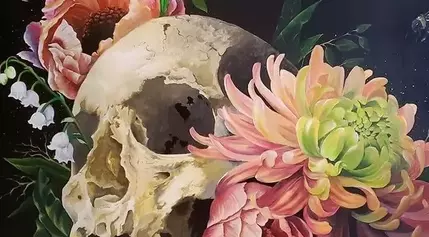The Arts + Education gallery at the Hoyt has unveiled two captivating exhibits this year, inviting visitors to explore the rich history of Youngstown and delve into a world of surrealism. The exhibitions, “Fabric of Time: Woven Portraits” by William Walker and “Doom and Bloom” by Lizz Ford, promise an immersive experience that bridges the past with contemporary artistry.Discover the Unseen Stories and Hidden Meanings Behind These Artistic Masterpieces
Exploring Local History Through Woven Threads
Upon entering the walkway between the two buildings, visitors are greeted by William Walker’s “Fabric of Time,” a collection of woven portraits that celebrate significant figures from Youngstown’s past. Each piece offers a unique glimpse into the city’s industrial and cultural evolution. With 14 portraits in total, the exhibit highlights individuals who played pivotal roles in shaping the community, including Elizabeth Fellows, George Wick, and Richard Mills. These names are not just etched in stone; they are woven into the very fabric of Youngstown’s identity.Walker’s interest in local history began during his college years when he embarked on a research project focused on theater revival. He was fascinated by the number of people involved in the performing arts and the substantial investments their work attracted. Many theaters started as modest local productions but eventually expanded into traveling troupes, making their mark on the national stage. Walker’s studies culminated in a master of art crafts degree from Kent State University, where he honed his weaving skills and incorporated historical figures into his work as a tribute to their contributions. His pieces have been recognized at prestigious institutions such as the Butler Institute of American Art and the Trumbull Art Gallery.
A Kaleidoscope of Colors and Surrealist Imagery
As visitors move up the walkway to the Main Galleries, they encounter a vibrant explosion of colors and bold imagery in Lizz Ford’s “Doom and Bloom.” This collection of surrealist paintings features large-scale works that challenge conventional perspectives. Ford often uses animals instead of humans to convey her messages, creating scenes that invite interpretation. For instance, a pigeon adorning its feathers with floral embroidery or a snake sprouting mushrooms from its scales—these images evoke curiosity and contemplation.Ford’s artistic philosophy is rooted in the Chinese concept of yin and yang, symbolizing opposing yet interconnected forces that maintain balance. Her paintings may allude to the complex relationship between humanity and nature, though she leaves much to the viewer’s imagination. On the surface, the works are visually stunning, but they also possess a deeper, more somber undertone. Ford’s approach to color and form creates a dichotomy that invites viewers to explore both the beauty and the darkness within each piece.Ford is a freelance artist and designer known for her custom digital metallic prints and diverse commissions, ranging from book covers to product packaging. Her passion for experimenting with pigments and creating custom paints adds a unique dimension to her work. By blending organic elements with surrealist perspectives, Ford challenges viewers to look beyond the obvious and uncover hidden meanings embedded within her art.
The Intersection of History and Art
Both exhibits offer distinct yet complementary experiences that resonate with audiences on multiple levels. Walker’s woven portraits provide a tangible connection to Youngstown’s history, while Ford’s surrealist paintings encourage introspection and personal interpretation. Together, these exhibits highlight the power of art to preserve the past and provoke thought about the present and future.The intertwining of historical figures and surreal imagery creates a dialogue between different eras and artistic expressions. Visitors can reflect on how the actions of those who came before us continue to influence our lives today. At the same time, they can engage with the abstract and symbolic language of surrealist art, finding new ways to interpret the world around them.
Engaging with the Community
These exhibits also serve as a platform for community engagement. The public reception scheduled for January 18 offers an opportunity for visitors to meet the artists and gain insights into their creative processes. It fosters a sense of belonging and shared appreciation for the arts, encouraging dialogue and interaction among attendees.Moreover, the free admission policy makes these exhibits accessible to a wider audience, promoting inclusivity and cultural enrichment. Whether you are a history enthusiast, an art lover, or simply curious about the intersection of the past and present, these exhibits provide a meaningful and enriching experience for all.

